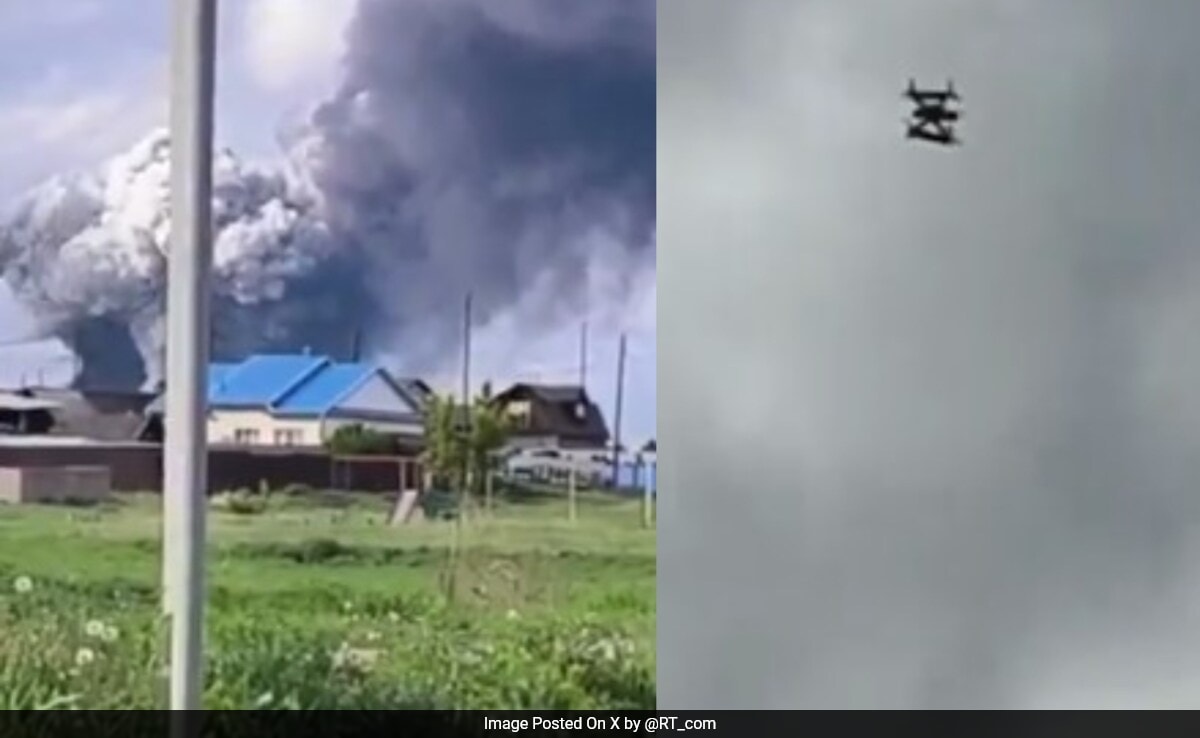Ukraine on Sunday orchestrated a massive drone attack targeting five key Russian military airbases in its “most long-range operation”, striking targets deep into Russian territory–thousands of kilometres from the front line. Under the covert operation code-named “Spider’s web,” Ukraine’s Security Service (SBU) struck at least 41 aircraft used to “bomb Ukrainian cities”, including Tu-95 and Tu-22 strategic bombers and the A-50 radar detection and command aircraft.
Moscow confirmed that five of its airfields in Murmansk, Irkutsk, Ivanovo, Ryazan, and Amur regions were targeted by Kyiv using first-person-view (FPV) drones.
“The Kyiv regime staged a terror attack with the use of FPV drones on airfields in the Murmansk, Irkutsk, Ivanovo, Ryazan, and Amur Regions. All terror attacks on military airfields in the Ivanovo, Ryazan, and Amur Regions were repelled. No casualties were reported either among servicemen or civilians. Some of those involved in the terror attacks were detained,” Russia’s defence ministry said in a statement on Sunday.
Moscow accepted that several of its aircraft “caught fire” in the attacks. “As a result of the launch of FPV drones from territories in close proximity to military airfields in the Murmansk and Irkutsk Regions, several aircraft caught fire. The fires were extinguished,” the statement said.
Modus Operandi Of Operation Spider’s Web
Ukraine regularly launches drones to strike targets in Russia in response to the Russian invasion of 2022, but the modus operandi used this time was different.
The operation “Spider’s web” was launched after the planning of over a year and a half, Ukrainian President Volodymyr Zelensky said, as he hailed “brilliant” results from “our most long-range operation” in more than three years of war. Zelensky said Ukraine deployed 117 drones in a massive attack, which hit “34 per cent of the strategic cruise missile carriers” at the targeted airfields.
According to Ukrainian SBU sources, the planning of the operation required particularly complex logistics. Drones were smuggled into Russia in advance. They were concealed under the roofs of wooden cabins installed on trucks. At the time of the attack, the structures’ roofs were opened remotely to let the drones fly toward their short-distance targets.
Ukrainian “Pavutyna” (spider net) operation is today’s attack launched simultaneously on four russia’s strategic aviation airbases has reportedly destroyed 40 (forty) strategic bombers on 4 (four) airbases: Belaya (4700 km from Ukraine), Dyagilevo (700 km), Olenya (2000 km),… pic.twitter.com/AYr5g7Xr7L
— Sergej Sumlenny, LL.M (@sumlenny) June 1, 2025
Photos shared by the SBU show numerous small black drones hidden in what appears to be transport containers.
Russia’s defence ministry confirmed that the drones were not launched from Ukrainian territory but “in the immediate vicinity of the airbases”.
The Belaya airbase in Irkutsk Oblast, which is around 4,300 kilometres from Ukraine, border and Olenya airbase in Murmansk Oblast, which is around 2,000 kilometres from the frontlines in the north, were hit under the attack. Video circulating online appears to show Russian aircraft in flames at these two airbases, with thick smoke rising above the tarmac.
The Russian ministry said it successfully countered other attacks in the regions of Ivanovo and Ryazan as well as in Amur, near the border with China in the Russian Far East.
‘Damage in Billions’
Ukraine’s SBU security service has claimed that it has hit Russian military planes worth a combined $7 billion in a wave of drone strikes. “$7 billion: This is the estimated cost of the enemy’s strategic aviation, which was hit today as a result of the SBU’s special operation,” the agency said in a social media post.
However, Russia has not confirmed the claim so far. SBU earlier claimed that coordinated attacks hit 41 aircraft used to “bomb Ukrainian cities”, claiming damage to Tu-95 and Tu-22 strategic bombers and the A-50 radar detection and command aircraft.
Russia’s defence ministry also confirmed that “several aircraft caught fire” following a drone attack at bases in the regions of Murmansk and Irkutsk, located in the Russian Arctic and eastern Siberia.
The fires were contained, the ministry said, and caused no casualties. Russia said it had arrested several suspects, including the driver of a truck from which a drone had taken off, state agencies said.
But Zelensky said people involved in preparing the attacks were “extracted from Russian territory in time”.
Timing
The long-planned operation came at a delicate moment three years into Russia’s invasion.
Ukraine’s President Volodymyr Zelensky said Sunday that he was sending a delegation to Istanbul led by his Defence Minister Rustem Umerov for talks on Monday with Russian officials.
Turkey is hosting the meeting, which was spurred by US President Donald Trump’s push for a quick deal to end the three-year war.
Zelensky, who previously voiced scepticism about whether Russia was serious in proposing Monday’s meeting, said priorities included “a complete and unconditional ceasefire” and the return of prisoners and abducted children.
Russia, which has rejected previous ceasefire requests, said it had formulated its own peace terms but refused to divulge them in advance.
Russian Foreign Minister Sergei Lavrov and his US counterpart Marco Rubio spoke by telephone Sunday about “several initiatives aimed at a political solution to the Ukraine crisis”, including Monday’s talks, the Russian foreign ministry said in a statement carried by the TASS news agency.



